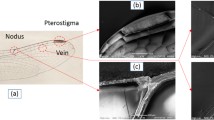Abstract
In this paper, the functionalities of microstructures for dragonfly wing during gliding flight are investigated. Three dragonfly-mimic airfoil-shaped wings with hybrid structures were designed and fabricated as: flat wing, zigzag-edged wing and zigzag-edged wing with pillar structure. Based on the wind tunnel experiments, the zigzag-edged wing structure significantly reduces the drag force in the gliding flight. Moreover, the drag reduction is more effective on the combination of the surface pillar and zigzag-edged structure. In addition, the zigzag-edged wing structure has less influence of Karman vortex street, and the surface pillars reduce the frictional drag and stabilized the streamline in the lower vortex region. Overall, the microstructure of the dragonfly wing is an important element in the aerodynamic study. These findings can enhance the knowledge of insect-mimic wing structure and facilitate the application of Micro Air Vehicle (MAV) in the gliding flight.
Similar content being viewed by others
References
Yanik M F. Towards gecko-feet-inspired bandages. Trends in Biotechnology, 2009, 27, 1–2.
Adithyavairavan M, Subbiah S. A morphological study on direct polymer cast micro-textured hydrophobic surfaces. Surface and Coatings Technology, 2011, 205, 4764–4770.
Porter M M, Ravikumar N, Barthelat F, Martini R. 3D-printing and mechanics of bio-inspired articulated and multi-material structures. Journal of the Mechanical Behavior of Biomedical Materials, 2017, 73, 114–126.
Liu H, Ravi S, Kolomenskiy D, Tanaka H. Biomechanics and biomimetics in insect-inspired flight systems. Philosophical Transactions of the Royal Society B: Biological Sciences, 2016, 371, 20150390.
Sivasankaran P N, Ward T A, Viyapuri R, Johan M R. Static strength analysis of dragonfly inspired wings for biomimetic micro aerial vehicles. Chinese Journal of Aeronautics, 2016, 29, 411–423.
Dickinson M H, Lehmann F, Sane S P. Wing rotation and the aerodynamic basis of insect flight. Science, 1999, 284, 1954–1960.
Dickinson M H, Gotz K G. The wake dynamics and flight forces of the fruit fly Drosophila melanogaster. Journal of Experimental Biology, 1996, 199, 2085–2104.
Wang Z J. Dissecting insect flight. Annual Review of Fluid Mechanics, 2005, 37, 183–210.
Sun J Y, Bhushan B. The structure and mechanical properties of dragonfly wings and their role on flyability. Comptes Rendus Mécanique, 2012, 340, 3–17.
Rajabi H, Ghoroubi N, Stamm K, Appel E, Gorb S N. Dragonfly wing nodus: A one-way hinge contributing to the asymmetric wing deformation. Acta Biomaterialia, 2017, 60, 330–338.
Rajabi H, Moghadami M, Darvizeh A. Investigation of microsctructure, natural frequecies and vibration modes of dragonfly wing. Journal of Bionic Engineering, 2011, 8, 165–173.
Ren H H, Wang X S, Li X D, Chen Y L. Effects of dragonfly wing structure on the dynamic performances. Journal of Bionic Engineering, 2013, 10, 28–38.
Sivasankaran P N, Ward T A. Spatial network analysis to construct simplified wing structural models for biomimetic micro air vehicles. Aerospace Science and Technology, 2016, 49, 259–268.
Zhao Y R, Wang D S, Tong J, Sun J Y. Nanomechanical behaviour of the membranous wings of dragonfly Pantala flavescens fabricius. Journal of Bionic Engineering, 2016, 13, 388–396.
Chen Y H, Skote M. Gliding performance of 3-D corrugated dragonfly wing with spanwise variation. Journal of Fluids and Structures, 2016, 62, 1–13.
Azuma A. Flight mechanics of a dragonfly. Journal of Experimental Biology, 1985, 116, 79–107.
Hou D, Zhong Z, Yin Y J, Pan Y H, Zhao H X. The role of soft vein joints in dragonfly flight. Journal of Bionic Engineering, 2017, 14, 738–745.
Birch J M. The influence of wing-wake interactions on the production of aerodynamic forces in flapping flight. Journal of Experimental Biology, 2003, 206, 2257–2272.
Jongerius S R, Lentink D. Structural analysis of a dragonfly wing. Experimental Mechanics, 2010, 50, 1323–1334.
Zhang S, Sunami Y, Hashimoto H. Deformation behavior of dragonfly-inspired nodus structured wing in gliding flight through experimental visualization approach. Scientific Reports, 2018, 8, 5751.
Gao C Y, Meng G X, Li X, Wu M, Liu Y, Li X Y, Zhao X, Lee I, Feng X Z. Wettability of dragonfly wings: The structure detection and theoretical modeling. Surface and Interface Analysis, 2012, 45, 650–655.
Zhang S, Zeng X, Matthews D T A, Igartua A, Rodriguez-Vidal E, Contreras Fortes J, Saenz de Viteri V, Pagano F, Wadman B, Wiklund E D, van der Heide E. Selection of micro-fabication techniques on stainless steel sheet for skin friction. Friction, 2016, 4, 89–104.
Wakeling J M, Ellington C P. Dragonfly flight. I. Gliding flight and steady-state aerodynamic forces. The Journal of Experimental Biology, 1997, 200, 543–556.
Thomas A L, Taylor G K, Srygley R B, Nudds R L, Bomphrey R J. Dragonfly flight: Free-flight and tethered flow visualizations reveal a diverse array of unsteady liftgenerating mechanisms, controlled primarily via angle of attack. Journal of Experimental Biology, 2004, 207, 4299–323.
Dean B, Bhushan B. Shark-skin surfaces for fluid-drag reduction in turbulent flow: A review. Philosophical Transactions of the Royal Society A: Mathematical, Physical and Engineering Sciences, 2010, 368, 4775–806.
Wacher J, Friedrich R, Plate E J, Dorsch F. Drag and lift on rectangular bluff bodies immersed in deep boundary layer flow over rough surfaces. Journal of Wind Engineering and Industrial Aerodynamics, 1990, 33, 113–122.
Author information
Authors and Affiliations
Corresponding authors
Rights and permissions
About this article
Cite this article
Zhang, S., Ochiai, M., Sunami, Y. et al. Influence of Microstructures on Aerodynamic Characteristics for Dragonfly Wing in Gliding Flight. J Bionic Eng 16, 423–431 (2019). https://doi.org/10.1007/s42235-019-0034-3
Published:
Issue Date:
DOI: https://doi.org/10.1007/s42235-019-0034-3




